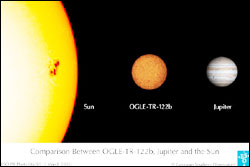This area deals with the fundamental laws and building blocks of nature and how they interact, the properties and the behavior of matter, and research into space and time and their structures.
innovations-report provides in-depth reports and articles on subjects such as astrophysics, laser technologies, nuclear, quantum, particle and solid-state physics, nanotechnologies, planetary research and findings (Mars, Venus) and developments related to the Hubble Telescope.

Livermore scientists are working to solve a 50-year-old question: Can neutrinos – a particle that is relatively massless, has no electric charge yet is fundamental to the make-up of the universe – transform from one type to another?
Scientists are using two giant detectors, one at Fermi Lab and another in a historic iron mine in northern Minnesota, to work on the answer.
As part of the international team working on the Main Injector Neutrino Oscillation Search (MINOS) proj

On February 15, 2005 of the Physics/Einstein Year, the complete story of the discovery of natural atom antihydrogen, started in 1985, was published on-line.
The antihydrogen problem has become a highly mediatic issue, both in the specialized physics and the more general press [1]. A real hype started at the end of 2002 when rivalling CERN-based groups ATHENA and ATRAP both claimed the production of large quantities of artificial antihydrogen. Scientists, wondering about a signatu

Very Large Telescope Finds Planet-Sized Transiting Star
An international team of astronomers have accurately determined the radius and mass of the smallest core-burning star known until now.
The observations were performed in March 2004 with the FLAMES multi-fibre spectrograph on the 8.2-m VLT Kueyen telescope at the ESO Paranal Observatory (Chile). They are part of a large programme aimed at measuring accurate radial velocities for sixty stars for which a temporary br

A program developed by Russian scientists under support from the International Science and Technology Center (Project 1917) helps to protect spacecraft from orbital debris that rushes at great speed, in the most effective and economic manner.
The system, under development by Russian scientists with financial support from the International Science and Technology Center, effectively and economically protects spacecraft from meteoroids and orbital debris. First tests, conducted by th

Antenna and telescope mirrors, walls and partitions for space stations, solar battery panels and even houses on the Moon and on Mars – all this can be achieved with technology developed by Russian scientists in the framework of ISTC projects 2835 and 2836. What is more, it can be achieved quickly, with good levels of strength and reliability, with minimal expense of time, space, energy and money.
These construction materials or, to be more accurate, original semi-products for futur

One year into its twelve year journey to Comet 67P/Churyumov-Gerasimenko, the European Space Agency’s (ESA) Rosetta mission will make a “close” flyby of Earth on Friday 4th March. UK scientists involved in the mission are hoping for a glimpse of the spacecraft which should be visible in the UK with the use of a telescope.
Whilst it has been visible to large amateur telescopes since 26th February, the best opportunity to view the spacecraft in Europe will be on Friday 4th March w